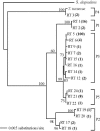Extensive variation in intracellular symbiont community composition among members of a single population of the wood-boring bivalve Lyrodus pedicellatus (Bivalvia: Teredinidae)
- PMID: 16391072
- PMCID: PMC1352252
- DOI: 10.1128/AEM.72.1.412-417.2006
Extensive variation in intracellular symbiont community composition among members of a single population of the wood-boring bivalve Lyrodus pedicellatus (Bivalvia: Teredinidae)
Abstract
Shipworms (wood-boring bivalves of the family Teredinidae) harbor in their gills intracellular bacterial symbionts thought to produce enzymes that enable the host to consume cellulose as its primary carbon source. Recently, it was demonstrated that multiple genetically distinct symbiont populations coexist within one shipworm species, Lyrodus pedicellatus. Here we explore the extent to which symbiont communities vary among individuals of this species by quantitatively examining the diversity, abundance, and pattern of occurrence of symbiont ribotypes (unique 16S rRNA sequence types) among specimens drawn from a single laboratory-reared population. A total of 18 ribotypes were identified in two clone libraries generated from gill tissue of (i) a single specimen and (ii) four pooled specimens. Phylogenetic analysis assigned all of the ribotypes to a unique clade within the gamma subgroup of proteobacteria which contained at least five well-supported internal clades (phylotypes). By competitive quantitative PCR and constant denaturant capillary electrophoresis, we estimated the number and abundance of symbiont phylotypes in gill samples of 13 individual shipworm specimens. Phylotype composition varied greatly; however, in all specimens the numerically dominant symbiont belonged to one of two nearly mutually exclusive phylotypes, each of which was detected with similar frequencies among specimens. A third phylotype, containing the culturable symbiont Teredinibacter turnerae, was identified in nearly all specimens, and two additional phylotypes were observed more sporadically. Such extensive variation in ribotype and phylotype composition among host specimens adds to a growing body of evidence that microbial endosymbiont populations may be both complex and dynamic and suggests that such genetic variation should be evaluated with regard to physiological and ecological differentiation.
Figures



Similar articles
-
Coexistence of multiple proteobacterial endosymbionts in the gills of the wood-boring Bivalve Lyrodus pedicellatus (Bivalvia: Teredinidae).Appl Environ Microbiol. 2002 Dec;68(12):6292-9. doi: 10.1128/AEM.68.12.6292-6299.2002. Appl Environ Microbiol. 2002. PMID: 12450854 Free PMC article.
-
Bacterial symbiont transmission in the wood-boring shipworm Bankia setacea (Bivalvia: Teredinidae).Appl Environ Microbiol. 2000 Apr;66(4):1685-91. doi: 10.1128/AEM.66.4.1685-1691.2000. Appl Environ Microbiol. 2000. PMID: 10742261 Free PMC article.
-
Phylogenetic characterization and in situ localization of the bacterial symbiont of shipworms (Teredinidae: Bivalvia) by using 16S rRNA sequence analysis and oligodeoxynucleotide probe hybridization.Appl Environ Microbiol. 1991 Aug;57(8):2376-82. doi: 10.1128/aem.57.8.2376-2382.1991. Appl Environ Microbiol. 1991. PMID: 1722662 Free PMC article.
-
Out of taxonomic crypsis: A new trans-arctic cryptic species pair corroborated by phylogenetics and molecular evidence.Mol Phylogenet Evol. 2022 Jan;166:107312. doi: 10.1016/j.ympev.2021.107312. Epub 2021 Sep 13. Mol Phylogenet Evol. 2022. PMID: 34530118 Review.
-
Remaining flexible in old alliances: functional plasticity in constrained mutualisms.DNA Cell Biol. 2009 Aug;28(8):371-82. doi: 10.1089/dna.2009.0872. DNA Cell Biol. 2009. PMID: 19435425 Free PMC article. Review.
Cited by
-
Secondary Metabolism in the Gill Microbiota of Shipworms (Teredinidae) as Revealed by Comparison of Metagenomes and Nearly Complete Symbiont Genomes.mSystems. 2020 Jun 30;5(3):e00261-20. doi: 10.1128/mSystems.00261-20. mSystems. 2020. PMID: 32606027 Free PMC article.
-
Gill bacteria enable a novel digestive strategy in a wood-feeding mollusk.Proc Natl Acad Sci U S A. 2014 Nov 25;111(47):E5096-104. doi: 10.1073/pnas.1413110111. Epub 2014 Nov 10. Proc Natl Acad Sci U S A. 2014. PMID: 25385629 Free PMC article.
-
Microbial distribution and abundance in the digestive system of five shipworm species (Bivalvia: Teredinidae).PLoS One. 2012;7(9):e45309. doi: 10.1371/journal.pone.0045309. Epub 2012 Sep 20. PLoS One. 2012. PMID: 23028923 Free PMC article.
-
Genetic diversity and potential function of microbial symbionts associated with newly discovered species of Osedax polychaete worms.Appl Environ Microbiol. 2007 Apr;73(7):2314-23. doi: 10.1128/AEM.01986-06. Epub 2007 Feb 2. Appl Environ Microbiol. 2007. PMID: 17277220 Free PMC article.
-
Phylogenetic analysis of microbial communities in different regions of the gastrointestinal tract in Panaque nigrolineatus, a wood-eating fish.PLoS One. 2012;7(10):e48018. doi: 10.1371/journal.pone.0048018. Epub 2012 Oct 25. PLoS One. 2012. PMID: 23133540 Free PMC article.
References
-
- Acinas, S. G., V. Klepac-Ceraj, D. E. Hunt, C. Pharino, I. Ceraj, D. L. Distel, and M. F. Polz. 2004. Fine-scale phylogenetic architecture of a complex bacterial community. Nature 430:551-554. - PubMed
-
- Baker, A. C. 2001. Reef corals bleach to survive change. Nature 411:765-766. - PubMed
-
- Cannone, J. J., S. Subramanian, M. N. Schnare, J. R. Collett, L. M. D’Souza, Y. Du, B. Feng, N. Lin, L. V. Madabusi, K. M. Muller, N. Pande, Z. Shang, N. Yu, and R. R. Gutell. 2002. The comparative RNA web (CRW) site: an online database of comparative sequence and structure information for ribosomal, intron, and other RNAs. BMC Bioinformatics 3:2. - PMC - PubMed
-
- Cavanaugh, C. M. 1985. Symbiosis of chemolithotrophic bacteria and marine invertebrates from hydrothermal vents and reducing sediments. Biol. Soc. Wash. Bull. 6:373-388.
-
- Distel, D. L. 2003. The biology of marine wood boring bivalves and their bacterial endosymbionts, p. 253-271. In B. Goodell, D. D. Nicholas, and T. P. Schultz (ed.), Wood deterioration and preservation, vol. 845. American Chemical Society Press, Washington, D.C.
Publication types
MeSH terms
Substances
Associated data
- Actions
- Actions
- Actions
- Actions
- Actions
- Actions
- Actions
- Actions
- Actions
- Actions
- Actions
- Actions
- Actions
- Actions
- Actions
- Actions
- Actions
- Actions
LinkOut - more resources
Full Text Sources
Other Literature Sources
Molecular Biology Databases

